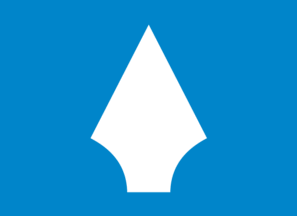 image by Tomislav Šipek, 05 February 2016
image by Tomislav Šipek, 05 February 2016Approved on 9 July 1976.

Last modified: 2025-04-05 by shreyas tallamraju
Keywords: alta | spearhead |
Links: FOTW homepage |
search |
disclaimer and copyright |
write us |
mirrors
 image by Tomislav Šipek, 05 February 2016
image by Tomislav Šipek, 05 February 2016
Approved on 9 July 1976.
Like many Norwegian municipalities, Alta looked back into history to find a suitable coat of arms. There is a tendency to favour charges that can be constructed as "Viking" in some way. In the case of Alta, there was opportunity to go even further back into history, into the Stone Age to uncover a suitable charge. The result of this "heraldic-archaeological expedition" was to use as a charge an spearhead of the type employed by the people of the Komsa Culture, a stone age culture that thrived in the area around Alta and which used spearheads made from quartzite. Alta is also known for its slate industry, making for instance tiles for roofing, and for copper mining. The spearhead may then also be interpreted as a drill used in these industries. As for the colour symbolism, silver/white stands for Alta's main natural resources, slate and fish, while blue stands for the sea, the river and the mountain plateau. This according to [cjo87].
Jan Oskar Engene, 27 April 2002
I read somewhere, probably in [cjo87], about the reasoning behind showing the pre-heraldic charges in the modern COAs (and flags). As we all well aware, the Norwegian modern municipal heraldry has very strict rules, returning to the roots of heraldry. Therefore, the charges representing real things (i.e. non-geometrical shield division) has one of the rules that govern them approximatley set as "the charge should be of form as the object has been used in the early heraldic period". I.e. the heraldic charges avoid modern shapes (say, latter then 14th-15th centruy) and also the earlier then say 10th century. However, in case of the pre-heraldic (pre-historic in this case) object, the principle is that they could be represented if they would be in any kind present in "heraldic society", i.e. if they would be possible to see them and recognize them in, say, 12th century. In this case, we may presume that the pre-historic spearheads might have been found laying around the area in 12th century... (Of course, there were spearheads used in 12th century of their own...)
Željko Heimer, 1 May 2002
You are partly right. There was indeed in the set of Norwegian heraldic norms, as enforced by the National Archives, a rule that said charges had to belong to the Medieval "circle of heraldic motives." However, this rule seems to have been relaxed, or even discarded altogether, and modern artefacts are now accepted. So, you will find modern lighthouses, mining equipment, a rig from the era of tall ships, even a circular saw blade. Among natural items belonging to the modern age, you will find strawberry and potato plants – both, I believe, imports into Europe following the rediscovery of the Americas in 1492. In my personal view, I am happy this happened. It allows heraldry a greater degree of freedom and it brings heraldry closer to contemporary reality.
Jan Oskar Engene, 2 May 2002
The flag of Alta is already reported, so here is coat of arms.
Source:
https://lovdata.no/dokument/OV/forskrift/1976-07-09-11?q=flagg
Tomislav Šipek, 05 February 2016
![[COA of Alta]](../images/n/no)20-12.gif) image by Tomislav Šipek, 05 February 2016
image by Tomislav Šipek, 05 February 2016
Official blazon in Norwegian: "I blått en hvit spydspiss."
Blazoned in English: "Azure a spearhead argent."
English blazon by Joe McMillan, 30 July 2002